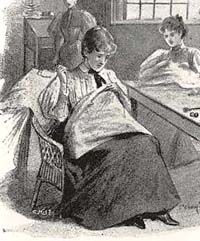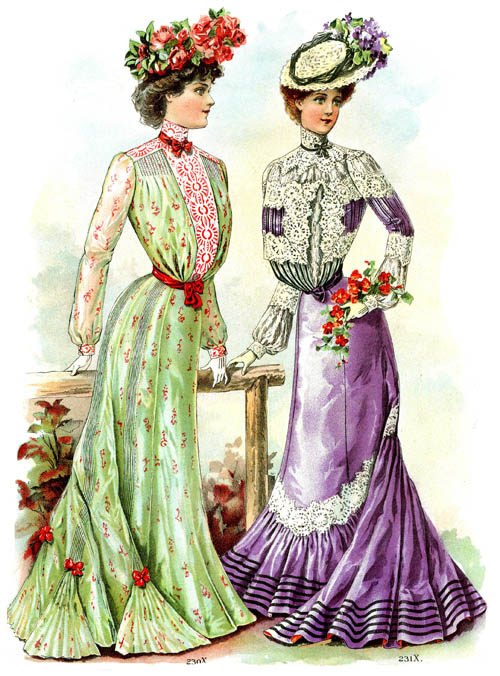|
Home > The Working World > Jobs & Careers > Trades & Professions

|
A host of trades were available to the working-class Victorian. Indeed, part of the whole controversy over "women's work" was the concept of the well bred gentlewoman becoming involved in "trade." Trade wasn't just a job, it was a class. People of the upper classes weren't supposed to be involved in "trade" - and tradesmen were expected to remember their place and never aspire to being a part of the upper classes. While many Victorian jobs have gone the way of buggy whip manufacturing, most of the trades and professions listed here are still active today.
|
-
- From Our Shop
(Demorest, 1874)
- A day in a dressmaker's shop.
- A Song of a Skirt, by Olive Logan (Cassell's Family Magazine, 1877)
- A woman sets out to give her dressmaking patronage to a poor, deserving dressmaker - and discovers there may be a reason why so many dressmakers are poor...
- A Contrast
(Girl's Own Paper, 1880)
- A parable on the working conditions of dressmakers.
- Gentlewomen as Dressmakers, by Elizabeth Lisle
(Girl's Own Paper, 1881)
- "Let us consider for a moment the average middle-class dressmaker -- the person who asks from 15s to £2 for making an ordinary gown..."
- The Emancipation of Seamstresses, by Anne Beale
(Girl's Own Paper, 1891)
- Millinery as a Career in Life
(Girl's Own Paper, 1892)
- Dressmaking as a Trade in Life
(Girl's Own Paper, 1892)
- How the Other Half Lives: The Dressmaker's Apprentice, by Elizabeth L. Banks
(English Illustrated Magazine, 1895B)
- Dressmakers and Milliners at Work and at Leisure
(Girl's Own Paper, 1896)
- Wholesale Millinery, by Gertrude Bacon
(Lady's Realm, 1901)
-
- Girls' Work and Workshops, by Ruth Lamb
(Girl's Own Paper, 1882)
- "In what number of handicraft trades are girls employed, and almost every fresh invention finds them more work to do." This multi-part article looks at girls working in cotton mills, lace factories, and silk mills; as sewing machinists and needleworkers; as makers of braid and trim; and as blacksmiths!
- Salt-Making in South Durham
(Cassell's Family Magazine, 1883)
- People Who Face Death in the Powder Mills, by A.E. Bonser
(Cassell's Family Magazine, 1895)
- The Cinderellas of the National Household: Jute Girls in the East End, by Lloyd Lester
(Girl's Own Paper, 1896)
- Details of work in the jute factories.
- The Cinderellas of the National Household: The Match-Makers of East London, by Lloyd Lester
(Girl's Own Paper, 1896)
- The match-making industry employed over 1000 women and girls, as well as out-sourcing "match box-making" to women working from home!
- Life in a Lancashire Cotton Mill, by John Foster Fraser
(Windsor Magazine, 1899B)
-
- How to Become an Engineer
(Cassell's Family Magazine, 1876)
- A Conversazione of Telegraph Engineers
(Cassell's Family Magazine, 1878)
- A look into the migratory life of the telegraph engineer employed by the submarine companies.
- On Submarine Telegraph Service, by J. Munro
(Cassell's Family Magazine, 1878)
- Six Months in a School of Telegraphy
(Cassell's Family Magazine, 1878)
- How to Become a Mechanical Engineer, by William H. Rideing
(Scribner's, 1879B)
- Career advice for "the boys of the family."
- The Profession of Electrical Engineering, by J. Munro
(Cassell's Family Magazine, 1891)
- Women as Telegraphers (Ladies' Home Journal, 1892)
- Two articles on the topic, one by a woman operator and one from a man's standpoint (both positive).
-
- How to Become a Barrister by A.D. Tyssen
(Cassell's Family Magazine, 1876)
- How to Become a Solicitor
(Cassell's Family Magazine, 1876)
- Lawyers' Morals
(Century Magazine, 1885A)
- Recommendations as to what these should be!
- Advice to a Young Lawyer
(Century Magazine, 1896A)
- A recently discovered package of letters with advice from Webster, Calhoun and others on the best course of study for a young lawyer.
- The Bar as a Profession, by the Lord Chief Justice of England
(The Strand, 1896A)
-
- A Cherub Up Aloft
(Cassell's Family Magazine, 1878)
- The life of the railway signalman who keeps watch "from above."
- How to Obtain a Clerkship in the Railway Service
(Cassell's Family Magazine, 1879)
- Railway Relief Associations, by L.O. Goddard
(Century Magazine, 1889A)
- Engine Drivers and Their Work, by Alfred Story
(The Strand, 1894B)
- People Who Face Death: Railway Men, by Henry Frith
(Cassell's Family Magazine, 1894)
- Railroad Employee Relief Associations, by Albert S. Bolles
(Century Magazine, 1898B)
- Interesting statistics on railroad pensions.
|
Visit Our Victorian Shop
for:
Books
Coloring Books
Beautiful Spiral Journals
Holiday Greeting Cards
|
|


 Discover thousands of Victorian images in our
Discover thousands of Victorian images in our 